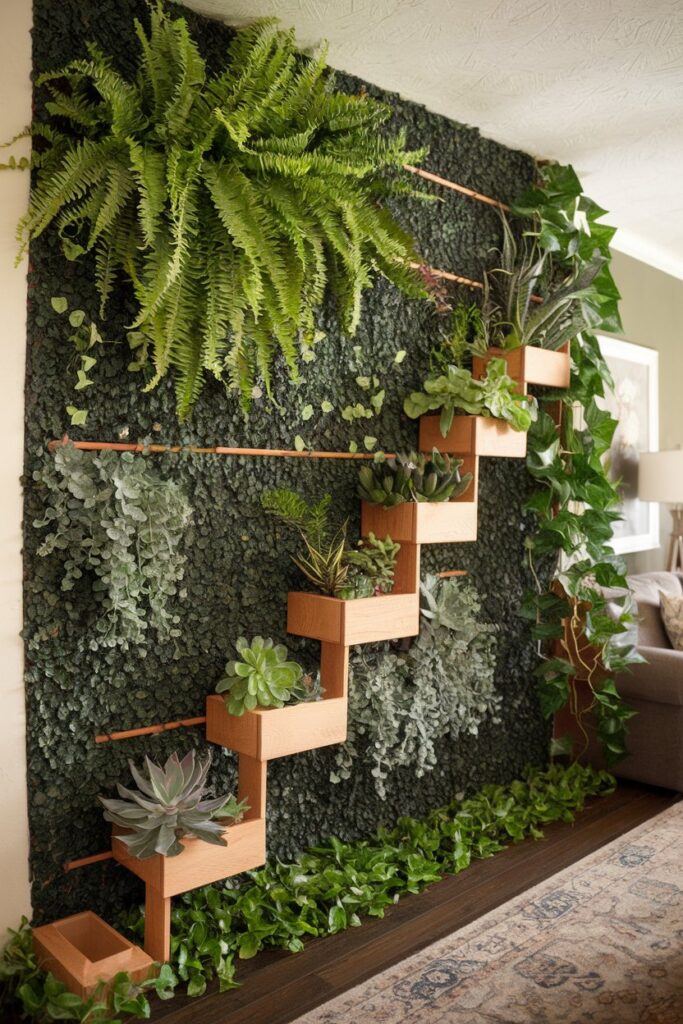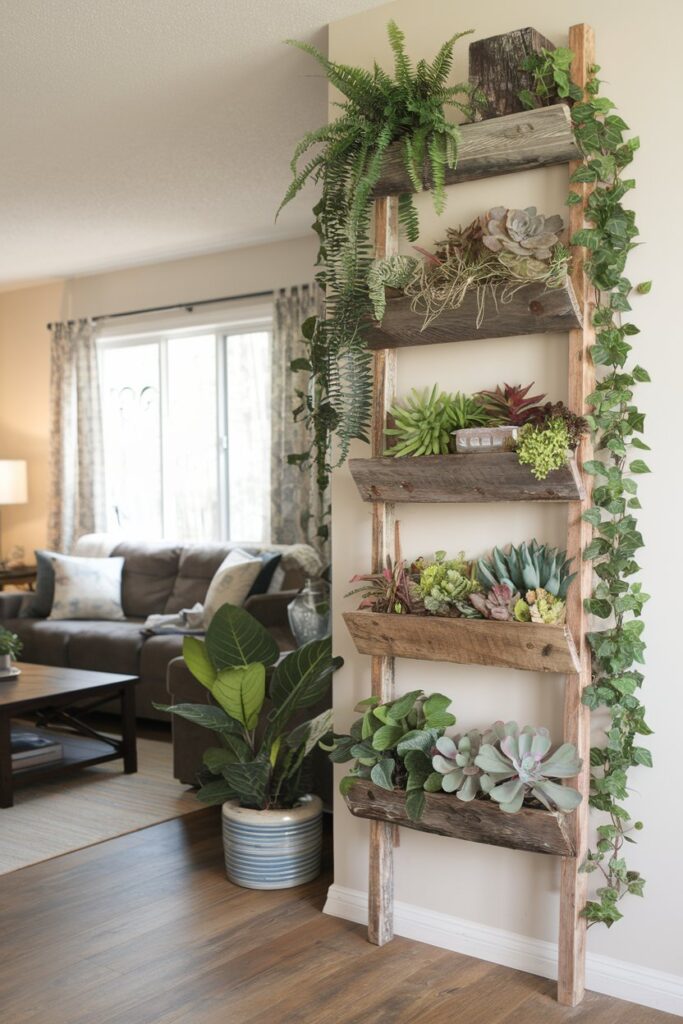A Beginner’s Guide to Transforming Your Space with an Indoor Vertical Garden
Craving a lush garden but limited by floor space? An indoor vertical garden might be the perfect solution! This innovative approach allows you to cultivate a vibrant green space by growing upwards, bringing nature into your home without sacrificing precious square footage. Whether you’re a seasoned plant enthusiast or a curious newcomer, this guide will walk you through the essentials of creating and maintaining a thriving indoor wall garden. From selecting the right plants to mastering care techniques, we’ll help you turn bare walls into a living, breathing ecosystem that enhances your living space and well-being.
Designing Your Indoor Living Wall: From Concept to Reality
Before you start stacking plants to the ceiling, let’s lay the groundwork for your indoor plant wall success.
Choosing the Ideal Spot for Your Vertical Garden
Light is crucial for your indoor vertical garden. Most plants need at least 6 hours of sunlight daily. South-facing windows are ideal, but east or west-facing can work too. No sunny spot? LED grow lights can mimic the sun’s rays, ensuring your plants get their daily dose of photosynthesis fuel.
Consider temperature and humidity as well. Most indoor plants thrive in temperatures between 60-75°F (15-24°C) and enjoy a bit of humidity. If your home is dry, a small humidifier near your vertical garden can work wonders.
When selecting your wall, ensure it can support the weight of your chosen system and fully grown plants. A sturdy wall without pipes or wires running through it is ideal. If you’re renting, consider a freestanding vertical garden system that won’t damage walls.
Selecting Your Vertical Garden Structure
From wall-mounted planters to freestanding systems, there’s a solution for every space and style. Here are some popular options:
- Pocket planters: Fabric pouches perfect for herbs and small plants.
- Modular systems: Stackable units that let you customize your garden’s size and shape.
- Ladders or Pallets: Upcycled wooden structures for a rustic, DIY-friendly look. Wooden ladder steps repurposed into shelves are excellent space savers.
- Floating shelves: Combine decor and greenery for a sleek, modern look.
- Trellis systems: Perfect for vining plants, creating a stunning green screen effect.
Consider weight capacity, ease of installation, and how it fits with your home’s aesthetic when choosing your structure.


Essential Gear for Your Indoor Living Wall Garden
Ready to get growing? Here’s what you’ll need:
- Planters or pots: Lightweight options with good drainage. Plenty of versatile options to choose from that mix practicality and beauty.
- Potting mix: Well-draining, nutrient-rich mix for indoor plants. Consider light and fluffy mixes when weight is a factor.
- Organic fertilizer: Slow-release formulas for easy feeding. Prepping soil with organic amendments that break down slowly will give your plants a boost when they need to start taking in additional nutrients
- Pruning shears: For regular maintenance and/or harvesting. When harvesting with shears, make sure to keep the cutting blades clean to not infect the plant.

Below are a few additional optional items:
- Watering system: Self-watering planters alleviate watering frequently while looking aesthetic. For longer periods of absence (like a vacation) consider a drip irrigation setup.
- Grow lights: Great way to supplement natural light with full-spectrum LED lights for low-light areas. Different color lights allow you to curate preferred looks.
- Trellis or support: For climbing or trailing plants. Adhesive hooks work well without putting holes in walls.
- Moisture meter: To avoid over or under-watering. Self-watering systems help eliminate the guesswork, however, a moisture meter is a helpful tool should there be any potential issue.

Best Plants for Indoor Living Walls: Green Thumb Not Required
Not all plants are created equal when it comes to vertical gardening. Here are some top performers for your indoor living wall planter:
Lush Leafy Greens
- Pothos: The ultimate beginner-friendly trailing plant.
- Ferns: Boston and bird’s nest varieties add texture and movement.
- Philodendron: Heart-shaped leaves in various colors.
- Spider Plant: Easy to grow and propagate.

Fab Flowering Options
- Peace lily: Elegant blooms and air-purifying power.
- Orchids: Add a touch of exotic beauty to your wall.
- African violets: Compact and colorful, perfect for small spaces.
- Bromeliads: Tropical plants with long-lasting, colorful blooms.

Edible Additions
- Herbs: Basil, mint, thyme, and oregano thrive in vertical setups.
- Lettuce and microgreens: Fresh salads, right from your wall!
- Cherry tomatoes: ‘Tiny Tim’ or ‘Red Robin’ varieties are compact and productive.
- Strawberries: Alpine varieties produce small, flavorful berries.

Low-Light Leaders
- Snake plant: Nearly indestructible and great for air quality.
- ZZ plant: Glossy leaves that thrive on neglect.
- Chinese evergreen: Variegated varieties add visual interest.
- Peperomia: Compact plants with thick, waxy leaves.

Caring for Your Indoor Living Wall Garden: Keep the Green Dream Alive
Your indoor vertical garden is up, but the journey’s just beginning. Here’s how to keep it thriving:
Watering Wisdom
Vertical gardens can dry out faster than traditional pots. Check soil moisture regularly and water when the top inch feels dry. A drip irrigation system can be a game-changer for larger setups. Water in the morning to reduce the risk of fungal growth.
For plants at different heights, remember that water naturally flows downward. Plants at the top may need more frequent watering, while those at the bottom should have excellent drainage to prevent waterlogging.

Fertilizing for Flourishing Growth
Feed your plants monthly during the growing season with a balanced, water-soluble fertilizer. Ease up in winter when growth slows. For edible plants, use an organic fertilizer to keep your harvests safe and healthy.
Consider using a diluted fertilizer solution more frequently rather than a strong dose less often. This mimics nature’s steady supply of nutrients and reduces the risk of burning your plants.
Pruning and Upkeep of Your Indoor Plant Wall
Regular trimming keeps your indoor plant wall looking its best. Remove dead leaves, pinch back leggy growth, and harvest herbs often to encourage bushiness. Rotate plants occasionally to ensure even growth, especially if they’re not getting light from all sides.
Don’t forget to dust your plants’ leaves periodically. Clean leaves can photosynthesize more efficiently, keeping your vertical garden lush and healthy.
Pest Patrol
Keep an eye out for common indoor pests like spider mites, mealybugs, and scale insects. Treat issues early with insecticidal soap or neem oil to prevent infestations. Introduce beneficial insects like ladybugs for natural pest control.
Regular inspection is key. Check the undersides of leaves and stem joints where pests often hide. A healthy, well-maintained garden is naturally more resistant to pest problems.

Troubleshooting Common Indoor Vertical Garden Issues
Even with the best care, you might encounter some challenges. Here are solutions to common problems:
- Yellowing leaves: Often a sign of overwatering. Let the soil dry out more between waterings.
- Leggy growth: Indicates insufficient light. Move plants closer to a light source or supplement with grow lights.
- Brown leaf tips: Usually due to low humidity or over-fertilization. Increase humidity and check your feeding routine.
- Wilting despite moist soil: Could be root rot. Ensure proper drainage and avoid overwatering.

